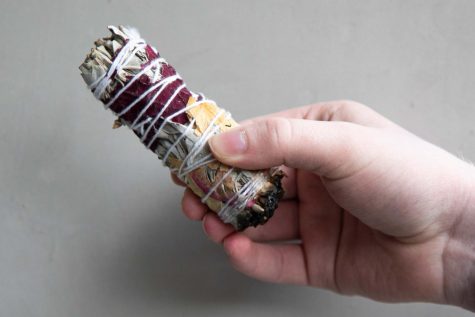Decolonizing spirituality: The harmful effects of borrowing from someone else’s culture
July 13, 2022

Editor’s note: This article is from the Communication Department’s award-winning Echo magazine
With the world going into lockdown March of 2020, people found themselves with a seemingly never-ending supply of free time. Some turned to bread making or knitting, some started exercising daily, and others turned to spirituality.
Malia Valentine, whose grandmother was part of the Unangan tribe from the Aleutian Islands of Alaska, says the pandemic also led people to search for healing through ancestral roots.
“I think building a relationship with yourself and your own ancestors, and your own ancestors’ story can really bring about a lot of healing, and, I think, a feeling of belonging that is maybe being sought after from looking at other people’s culture,” Valentine says.
Valentine said many Americans don’t have a strong connection to their own ancestors and cultural background anymore. Because of this, some have turned to cultures that are not their own.
The use of white sage to cleanse a room or person is one such popular practice among the spiritual community taken from Indigenous communities. It’s used in smudging, an Indigenous practice in which sacred herbs are burned for a ritual. Now, due to overharvesting of the plant, Indigenous people and conservationists have warned that white sage could be in danger of extinction.

Chakras, yoga, spirit animals and dream catchers have also been repurposed and mass marketed to the general public, ignoring the initial cultures they came from.
“It’s so much easier to see that sage plant, or that song, or that ceremony as just an object, some sort of isolated object that is just existing on its own, ready to be consumed,” Valentine says. “Instead of seeing it as its own entity, with its own deep, deep, deep stories, and its own large, large web of relationships.”
Valentine meets with Indigenous communities across the country, helping them protect their land and sacred sites; currently, she’s working with the Winnemem Wintu tribe of Northern California.
In doing this work, Valentine says, she’s seen the harmful effects of cultural appropriation firsthand.
“There’s this pretty strong feeling of entitlement to the lands on the mountain, and in the spring, and even when the Winnemem Wintu are there, and they’re asking, ‘Please respect these sacred places.’ People are really quite adamant,” Valentine says. “The people that I’ve mostly interacted with are white, or at least white-appearing, and are still really entitled to their right to be there.”
Valentine says she’s seen people become aggressive when they are asked to leave a sacred site, which is difficult for tribes to deal with. People sometimes view aspects of Native culture such as white sage or spirit animals as isolated objects, rather than honor the historical context and meaning behind them, she says.
Samantha Andersen, a 23-year-old Pagan witch from Huntley, Illinois, first began to explore spirituality when she saw her sister use tarot cards. Tarot cards are used for divination, originating in 14th century Europe. They were used for parlor games until about the late 16th century, when people began using them to foretell the future.

Now, there are multiple different types of tarot cards. The practice is open, meaning anyone who wishes to can learn how to read tarot. But not all practices are as welcome to all, and more people are borrowing from cultures that are not their own.
“People sometimes will take certain aspects from certain practices and combine them all into one,” Andersen says. “And I think that’s where some of the issues are coming from. People take little practices that they think are really interesting or really popular, and they’ll kind of use it without really knowing where it comes from, or what it actually means.”
Lesley Calvillo, co-founder and president of Call of the Cauldron, a club of witches at Columbia College Chicago, says the club has sessions dedicated to stopping cultural appropriation in witchcraft. She says many of their members are younger and appropriate a culture due to lack of knowledge.
“It’s a big thing, especially with white sage, or the term black magic, or different things like that,” says Calvillo, who has been practicing witchcraft for three years. “It’s very prevalent, and not a lot of people realize that it’s offensive, or appropriation. Which again, I wish people would do their research more. But also, we need to have more open conversations about it.”
Alex Kropp, a 20-year-old witch from Chicago, says much of modern spirituality is derived and adapted from cultural practices, but it’s important to know when practices can be shared versus when they have been stolen. Kropp says researching is the best way to find out what practices are open and what practices are closed. Cross-referencing with multiple sources is essential.
If people want to learn about native tribes and their work, Valentine says, they should first build relationships with other communities by helping them and learning from them. Going in with an open mind to truly learn and assist can help build those connections, and help people find the healing they crave, she says.
You can read the entire 2022 issue of Echo, as well as previous issues, on our website.







